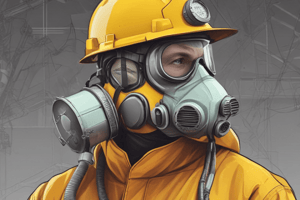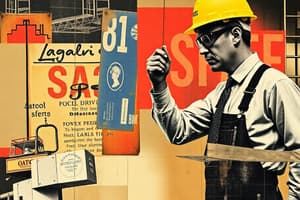Podcast
Questions and Answers
What is the mission of the Occupational Safety and Health Administration (OSHA)?
What is the mission of the Occupational Safety and Health Administration (OSHA)?
To send every worker home whole and healthy every day
What causes electric shock?
What causes electric shock?
- You use a dry hand
- You touch an insulated wire
- Your body becomes part of the circuit (correct)
- You are standing on rubber
What common-sense steps should workers take to protect themselves from falls?
What common-sense steps should workers take to protect themselves from falls?
-- Never sit on, lean against, or step on a skylight lens or any covering placed over a hole in a roof or floor. -- Guard or securely cover all holes created or uncovered before leaving a work area. -- Always use a PFAS when working over an unguarded or uncovered opening more than six feet above a lower level.
What are the two steps for avoiding hazards before considering PPE?
What are the two steps for avoiding hazards before considering PPE?
What are the three main types of scaffolds?
What are the three main types of scaffolds?
What must cranes and derricks that hoist personnel do?
What must cranes and derricks that hoist personnel do?
What should workers do if power tools can create flying debris?
What should workers do if power tools can create flying debris?
How does OSHA define an excavation?
How does OSHA define an excavation?
What should a proper lifting techniques training program cover?
What should a proper lifting techniques training program cover?
What does mechanical demolition refer to?
What does mechanical demolition refer to?
On what standards are OSHA's electrical standards based?
On what standards are OSHA's electrical standards based?
What are the four main types of electrical injuries?
What are the four main types of electrical injuries?
What factors affect the severity of a shock?
What factors affect the severity of a shock?
Where do electrical burns most often occur?
Where do electrical burns most often occur?
What colors are hot wires usually?
What colors are hot wires usually?
What causes more than 50 percent of electrocutions?
What causes more than 50 percent of electrocutions?
What does the OSHA standard require for flexible cords?
What does the OSHA standard require for flexible cords?
What is the most frequent violation of OSHA electrical standards?
What is the most frequent violation of OSHA electrical standards?
What are the three elements of a basic program for electrical safety?
What are the three elements of a basic program for electrical safety?
What should be done to damaged portable electric tools?
What should be done to damaged portable electric tools?
What is the acceptable action if you have a three-prong plug and a two-hole receptacle?
What is the acceptable action if you have a three-prong plug and a two-hole receptacle?
What are the five basic safety rules for using power tools?
What are the five basic safety rules for using power tools?
What must live parts of electric equipment operating at 50 volts or more be?
What must live parts of electric equipment operating at 50 volts or more be?
What must circuits be doing while any employee is exposed to contact with de-energized parts?
What must circuits be doing while any employee is exposed to contact with de-energized parts?
Low voltage does not mean low hazard.
Low voltage does not mean low hazard.
Flashcards are hidden until you start studying
Study Notes
OSHA Mission
- Mission: Ensure every worker returns home whole and healthy daily.
Electricity and Electric Shock
- Electricity flows in closed circuits; shock occurs when the body becomes part of the circuit.
Fall Protection Measures
- Do not sit, lean, or step on skylight lenses or covers over holes.
- Securely cover all holes before leaving work areas.
- Utilize Personal Fall Arrest Systems (PFAS) for heights over six feet.
Hazard Avoidance Steps
- Implement workplace and engineering controls prior to considering Personal Protective Equipment (PPE).
Scaffolding Types
- Main types of scaffolds: aerial lifts, supported scaffolds, and suspended scaffolds.
Crane and Derrick Safety for Personnel
- Cranes must have a firm foundation, be level within 1% of grade.
- Movement of personnel platforms must be slow and cautious; use rotation-resistant ropes.
- All brakes and locks on cranes must be engaged when stationary.
Protection from Power Tool Hazards
- Use appropriate PPE when operating power tools that produce flying debris or sparks.
Definition of Excavation
- Excavation is any man-made cavity, depression, trench, or earth cut formed by earth removal.
Proper Lifting Techniques Training
- Training must include the spine, muscles, and joints anatomy.
- Emphasize safe lifting postures and timing.
Mechanical Demolition Equipment
- Involves tools like wrecking balls and jackhammers.
OSHA Electrical Standards
- Based on the National Electrical Code (NEC).
Types of Electrical Injuries
- Main types include: electrocution, electric shock, burns, and indirect injuries (e.g., falls).
Severity of Electric Shock
- Severity factors: length of exposure, amount and frequency of current, and current path.
Electrical Burns
- Most severe burns typically occur on hands due to direct current contact.
Identification of Hot Wires
- Hot wires are usually black or red and ungrounded, posing shock hazards.
Causes of Electrocutions
- Over 50% of electrocutions result from contact with energized power lines.
Flexible Cord Requirements
- Flexible cords must be rated for hard or extra hard usage.
Common OSHA Violations
- Most frequent violation: improper grounding of circuitry and equipment.
Electrical Safety Program Elements
- Essential elements include: recognize hazards, evaluate risks, and control dangers.
Handling Damaged Portable Electric Tools
- Damaged tools must be removed from service and tagged "Do Not Use."
Adapter Use for Electrical Connections
- Acceptable to use an adapter with a three-prong plug when connected to a known ground.
Power Tool Safety Rules
- Five rules include: maintain tools, inspect before use, follow manufacturer instructions, use proper PPE, and select the right tool for the job.
Guarding Live Parts
- Live electric equipment operating at 50 volts or more must be protected from contact.
Lockout/Tagout Procedures
- Circuits must be locked or tagged when personnel are exposed to de-energized equipment or circuits.
Low Voltage Hazards
- Low voltage does not imply low hazard; risks still exist.
Studying That Suits You
Use AI to generate personalized quizzes and flashcards to suit your learning preferences.




